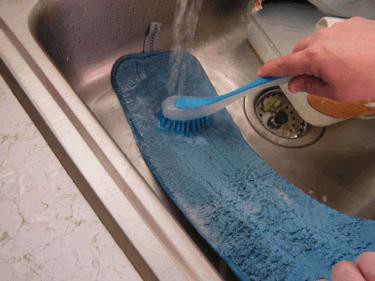Apply a drop or two of dish shampoo onto the pad. Scrub the pad under hot running water with our dish brush.
When too dirty or after a couple of cleanings, microfiber should be preferably machine washed. For that purpose any standard detergent like Tide etc can be used.
Water temperature should not exceed 90°C (ab. 200°F).
Microfiber is quick to dry and can be machine-dried at temperature not exceeding 60°C (ab. 140°C).
Things to avoid: Do not use fabric softener when washing microfiber. Softener would act as a kind of wax, recovering the fibres surface, clogging up the micro spaces that are efficient to trap dusts and also cancelling the fibres chemical and electrostatic properties. Microfiber can be washed with other kind of textile provided they are lint-free.
No terry cloths or dryer sheets for instance! Otherwise lint would clog the fibres as well and reduce their efficiency.
If those mistakes have been committed, microfiber should be rewashed in order to recover its properties.
Like most plastics microfibers are resistant to a lot of chemical products. However do not use chlorine bleach on microfibers and avoid using acetone (it can damage polyester fibres) or strong acids (it can damage nylon fibres).
Life expectancy of good quality microfiber can be very long compared to other similar cleaning products and provided it is cared for properly. Any good microfiber should resist more than 200 laundries and up to 500.
To that point microfibers can still maintain their properties but the fabric might be falling apart.


